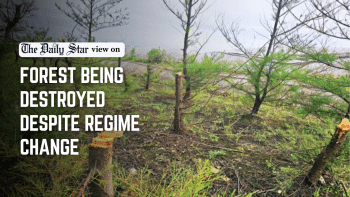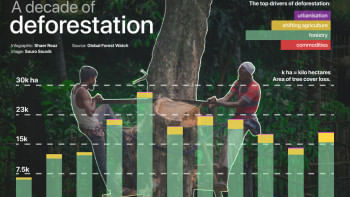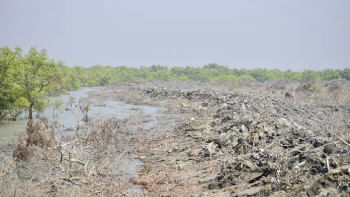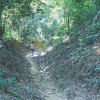Preserving our future by saving our forests

With the recent fall of an authoritarian regime and an interim government in place, the expectations and demands of people in Bangladesh are skyrocketing, and there is a desire to take full advantage of new opportunities and possibilities. In a similar vein, conservationists and natural resource management professionals expect the management of forests and other resources to be more effective now, protecting the long-term interests of the country and its population.
Previous regimes were more concerned about success stories in all sectors, with fabricated success carefully covering unattended challenges. Political interference was widespread in institutional decision-making, leading to wastage of public resources, ignorance of expert opinions, and forsaking of participation and stakeholder consultation. Against this backdrop, the Forest Department and other related agencies gradually drifted far from their due course.
The interim government may weigh on several issues that I believe are crucial for transforming the public forest management system into a more transparent and accountable one.
One such issue is data tampering and the misrepresentation of facts. It has been customary, over the past decade, to present exaggerated scenarios in terms of achievement. For instance, the data regarding national forest cover, which was shown to be around 12.6 percent, while it is in reality around 8.6 percent. These has immense bearing on our national forest coverage targets, and the targets against the relevant SDGs, policy, plans, and strategies, as the distorted data places us on an impractical trajectory.
Therefore, the scholarly demand is to correct the course through updating Bangladesh's actual forest cover data, and reconsider various national targets accordingly.
Most of the forest and relevant laws in practice are from the British regime, and devoid of any consideration of the people. Moreover, parts of the reserved forests are declared as Protected Areas to fulfil international obligations, which further limits accessibility and the rights of the people. It has never been a practice of the Forest Department to arrange public consultation while declaring public forests as Protected Areas. At present, 52 percent of the Sundarbans forest (including the waterways) has been declared as Protected Areas with harsher usage regulations. This often makes the lives of forest-dependent locals miserable, and ultimately results in exacerbated illegal practices.
The rights of local communities should be ensured by revising the boundaries of declared Protected Areas and subsequent declarations. Alongside the Protected Areas management plan, a mandatory management requirement for each Protected Area should be prepared for real action to fill the missing gaps.
Another area of concern is the Chittagong Hill Tracts (CHT), an underutilised hidden gem for forest restoration and carbon conservation. Despite the widespread deforestation (522,158 ha) and forest degradation (146,210 ha) in the CHT region, efforts are not being taken to restore it at scale because of the conflicting land management responsibilities of the various departments. Some part of the CHT forest land is managed by the Forest Department, termed as reserved forests, while most of it is under the management of the deputy commissioners representing the land ministry, often termed as unclassified state forests. The latter has no mandate to prevent forest degradation or restoration; therefore, the lands are undergoing further degradation due to massive expansion of agriculture and horticultural crops. The Forest Department, on the other hand, has no functional ties or programmes under the administrative structures created in light of the 1997 CHT Accord.
However, appropriate community-based forest conservation programmes could increase forest cover by eliminating conflicting land uses and create further opportunities to foster employment in the hills, generate timber and non-timber products, secure livelihoods and thus reduce landslide, soil erosion and siltation, improve watersheds, regulate local climate, and achieve both national REDD+ and Nationally Determined Contribution (NDC) targets. Furthermore, it is possible to earn a considerable amount of foreign currencies from the voluntary or regulatory carbon markets through emission reduction by carbon conservation in the forests.
Unfortunately in the forestry sector, we see exclusionary, vested interest-led and often politically biased, inefficient and even unnecessarily planned and implemented development programmes. Some salient examples include the installation of non-profitable and useless ropeway in the name of Sheikh Russel Aviary and Ecopark in Rangunia, the establishment of a safari park at Lathitila forest and numerous ecoparks. Some of these initiatives have caused irreparable harm to forests and wildlife and enabled embezzlement and wastage of public money.
To ensure resourceful forest conservation activities, the Forest Department has drafted a forest policy and a forestry master plan using huge debt investment; it has been awaiting approval for eight years. These forest policy and forestry master plan should be discussed, approved and implemented immediately before these become obsolete.
Even more concerningly, the Forest Department does not have the capacity to prevent encroachment. Even though enormous lands—104,000 hectares—have already been encroached, the field-level staff are still putting their life at risk to prevent encroachment and hill-cutting, resulting in physical assaults and even death of forest personnel in the recent past.
Shockingly, the Government and Local Authority Lands and Buildings (Recovery of Possession) Ordinance, 1970 currently in use did not retain the legal power of divisional forest officers for eviction, which was in the earlier ordinance. After sending the list to the deputy commissioners, the Forest Department must wait for the eviction orders and the appointment of magistrates. By the time all approvals are obtained, the forest is already encroached upon and destroyed. Actions for evictions, if ever, are taken from the office of the deputy commissioner. However, these are often purely populist, bowing down to the wishes of political leadership.
If forests and wildlife habitats are to exist, necessary legal power needs to be given to stop encroachment and protect them. The misuse of forests cannot go on any further. People should stand up for forests, for only then will forests survive—and so will people.
Rakibul Hasan Mukul is deputy chief conservator of forests at the Forest Department (lien), executive director at Arannayk Foundation, and organising secretary at the Institution of Foresters Bangladesh (IFB). He can be reached at [email protected].
Views expressed in this article are the author's own.
Follow The Daily Star Opinion on Facebook for the latest opinions, commentaries and analyses by experts and professionals. To contribute your article or letter to The Daily Star Opinion, see our guidelines for submission.

 For all latest news, follow The Daily Star's Google News channel.
For all latest news, follow The Daily Star's Google News channel. 











Comments